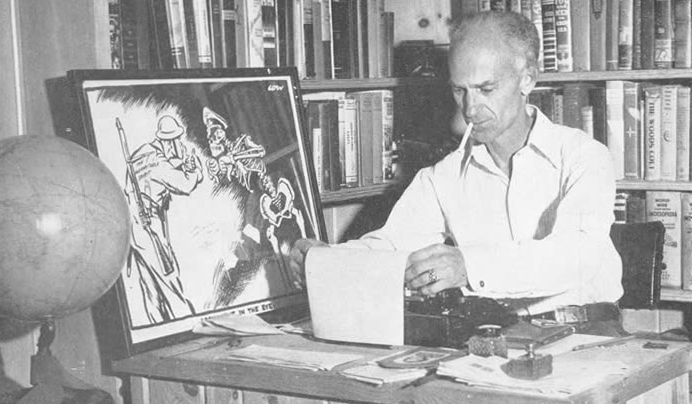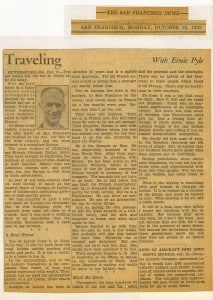California History, General History, People, Wine and Viticulture
Ernie Pyle
Today the Los Angeles Times ran a fascinating article about Ernie Pyle, the Pulitzer-prize winning journalist. He was most famous for his articles covering the US involvement in World War II, but he was also the country’s first aviation correspondent. In the 1930s, after a severe bout of the flu, he vacationed in California, a trip he spun into several wildly popular travelogues detailing his trips across America.
After the attack on Pearl Harbor, Pyle became a war correspondent and spent most of the rest of his life with the US Navy in the Pacific Theater. He was killed by Japanese machine gun fire on April 18, 1945, on the island of Iejima. Because he was so beloved and respected for his involvement in covering the war, Pyle is the only non-military person buried in the National Memorial Cemetery of the Pacific in Honolulu, and one of only a few citizens to be awarded the Purple Heart.
What does all that have to do with Napa? Well, turns out during his traveling years, Pyle visited the Napa Valley. In particular, he spent time with the de Latours, the owners of Beaulieu Vineyards in Rutherford. Pyle was as moved by the de Latours and their winery as Robert Louis Stevenson was by the Schrams was back in the 19th century, but he also for the first time felt a personal connection to the war. In October 1939, the US was still a few years away from joining the fray, but Europe had only just witnessed the Invasion of Abyssinia (1935) and the Invasion of Poland (September 1939), as well as the rapid expansion of the Japanese Empire (the Invasion of Manchuria, 1931, and Battles of Khalkhin Gol, May-September 1939).
For the US, a nation still pulling itself out of a devastating Great Depression, that all seemed very far away, but Pyle discovered how a global issue could have local impact:
I’ve not before felt the war so closely as we did today.
For we had lunch in a home whose every movement is touched by war. Beside me sat a young woman whose husband just yesterday sailed to fight for France.
All those lovely valleys among the hills north of San Francisco are touched by the war. For this is the wine country, and the wine country is a miniature Europe.
The great vintners of California are French, German, Italian, Swiss. They have brought to California the heritage of centuries of wine-making in their families. Mostly they are American citizens now, and good ones, too, but Europe is still close to them nevertheless.
As part of our wine-country tour we were invited to lunch at the country home of Georges de Latour, one of California’s meticulous growers of high-quality grapes…
They have two children. Their son is in France now, but will come home as soon as he can get passage. Their daughter, Helene, is here with them. It is Helene whom the war has already cut deeply, for her husband is on the sea, returning to fight for France.
He is the Marquis de Pins. He was desperately wounded in the first World War. After their marriage he came to American with Helene. He has been active in the Beaulieu Wineries…The marquis did not have to go back. He is just above the age limit for French conscription; also he is wounded beyond the capacity for front service. But he is a Frenchman. He can drive an ambulance. He can be an interpreter. He can do many things.
And so, paying his own passage, he left the great security of a California valley, and his wife and daughter at home, and went once again to war.
Throughout the long luncheon we talked of the war and the leaders and the generals and the strategies. There was no hatred of the Germans in these people whose blood is all French. There was no fanaticism in their emotions. To them it was a job that must be done. How it will end we could not prophesy. There was no dramatic positiveness of an inevitable victory. But there was that sense of knowing that Frenchmen don’t give up. And a feeling that, although it starts slowly, when the colossal weight of the vast British Empire finally gets rolling it has an almost inconceivable momentum.
See the article below for the full details of Ernie Pyle’s trip.



